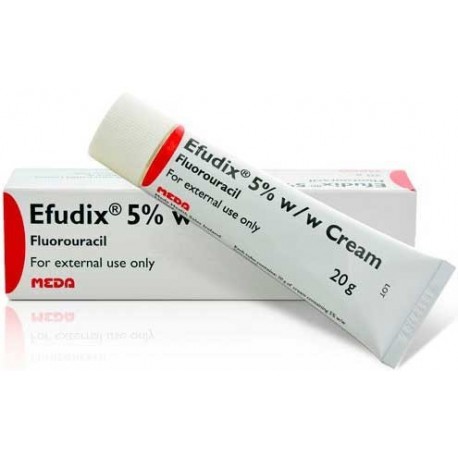 View larger
View larger Efudex cream 5% (fluorouracil) 20 G
EFD2088
New product
BUY MORE PAY LESS
| Quantity | Discount | |
|---|---|---|
| 2 | 5% | |
| 3 | 10% | |
| 4 | 15% | |
| 5 | 20% |
Volume discounts
| Quantity | Discount | You Save |
|---|---|---|
| 2 | 5% | Up to $4.90 |
| 3 | 10% | Up to $14.70 |
| 4 | 15% | Up to $29.40 |
| 5 | 20% | Up to $49.00 |
More info
What is Efudix Cream?
This cream is used for the local treatment of malignant skin lesions such as keratoses, keratoacanthoma, Bowen's disease, superficial basal cell carcinoma, including senile, actinic and arsenic forms. Deep, penetrating, or nodular basal cell and squamous cell carcinomas usually do not respond to Efudix cream treatment. In such cases where no other treatment is possible, this cream should be used only as a palliative treatment.
What Does Efudix Cream Do?
This cream is used to treat precancerous and cancerous growths that affect the outer layer of the skin caused by aging or exposure to sunlight. This cream is applied to heal and treat skin conditions such as keratoses, including senile, actinic and arsenic forms, as well as sunspots, Bowen's disease (a type of skin cancer), superficial basal cell carcinoma (a type of skin cancer), and keratoacanthoma.
Efudix Cream Benefits
This cream is a drug used for the removal of skin lesions such as keratoses, solar keratoses, sunspots, keratoacanthoma, Bowen's disease, superficial basal cell carcinoma, including senile, actinic and arsenic forms.
Things to Know Before Using Efudix Cream
The normal response pattern is early and severe inflammatory phases (characterized by erythema, which can become dense and blotchy in the skin in general), a necrotic phase (characterized by skin erosion), and finally healing (characterized by epithelialization occurring). The clinical manifestation of the response usually occurs within the second week of treatment with this cream. However, these treatment effects can sometimes be more severe and include pain, blistering and ulceration. Occlusive dressing can increase the inflammatory reactions of the skin.
You should not smoke or approach a fire while using this cream. Otherwise, there may be a risk of serious burns. Fabric (such as clothing, bedding, dressing) that comes into contact with this product will burn more easily and pose a serious fire hazard. Washing clothing and bedding can reduce, but not completely eliminate, product buildup.
Exposure to UV radiation such as natural sunlight, solariums and tanning beds should be avoided while using this cream.
Pre-existing subclinical lesions may become evident following use of this cream.
Any serious skin condition during treatment with this cream can be alleviated with the use of an appropriate topical steroid cream.
This cream should have minimal effect on healthy skin when used according to approved prescribing information.
An interval of at least four weeks should elapse between treatment with brivudin, sorivudine or its analogues and the next administration of Efudix.
Excipients, stearyl alcohol and propylene glycol, may cause local skin irritations (eg contact dermatitis). Excipients methyl parahydroxybenzoate and propyl parahydroxybenzoate can cause allergic reactions.
There are no adequate data on the use of this cream in pregnant women. Pregnant women should consult a doctor before using this cream.
Women of childbearing potential should not become pregnant during treatment with this cream and should use an effective method of contraception during treatment. If a pregnancy occurs during treatment, the patient should be informed of the risks to the child of treatment-related side effects and genetic counseling is recommended.
There is no information available on the passage of this cream into breast milk. A risk to the breastfed child cannot be excluded, so this cream should not be used in nursing mothers. If use during breastfeeding is absolutely necessary, breastfeeding should be discontinued.
Use of Efudix Cream
Carefully follow all instructions given to you by your doctor or pharmacist. They may differ from the information contained in this brochure.
Apply this cream as recommended by your doctor. Using a non-metallic applicator, cotton swab or rubber glove, apply a thin layer of the cream to the affected areas of your skin and rub gently. Do not use too much cream.
Be very careful not to let this cream come into contact with the mucous membranes. Take care that this cream does not come into contact with mucous areas such as eyes, eyelids, nostrils and lips. Wash your hands carefully and thoroughly immediately after using this cream. If your doctor asks you to apply a concealer dressing after using this cream, apply a new concealer dressing to the affected area daily.
Apply this cream once or twice a day as recommended by your doctor. Reapply in the morning and then in the afternoon or early evening. Do not apply this cream just before going to bed. Contact with pillows or sheets may cause undesirable spread of this cream on normal skin that does not require treatment. Take your medicine at about the same time every day. Using this cream at the same time every day will provide the best effect. It also helps you remember when to use it.

